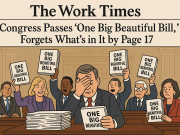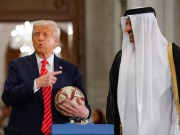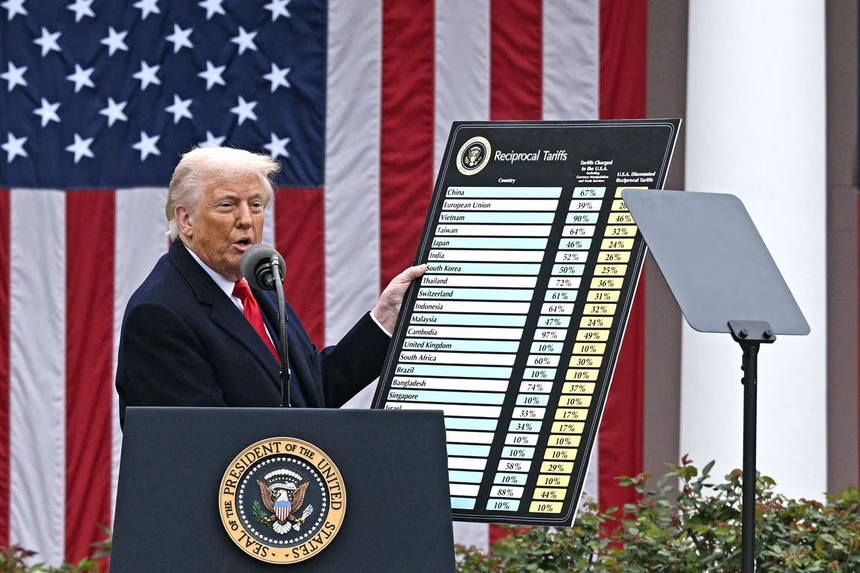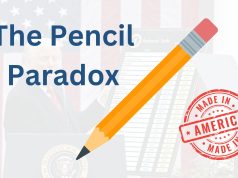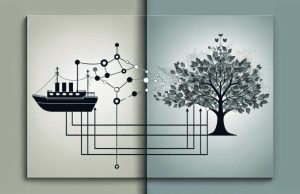In the tale of the porcupine and the leopard—an African fable whispered in the winds of the savanna—the leopard learns a hard lesson. It lunges at the porcupine for a quick meal, only to retreat, injured by a forest of spines. Moral? In nature, even the smallest creatures have defenses that cut both ways.
So too, in the grand theater of global economics, the tariff is not merely a tool—it’s a porcupine’s quill. Sharp when needed, but painful if wielded without care. And with the recent “Liberation Day” tariffs blanketing imports from 184 countries, it’s worth asking: have we struck a strategic blow for fairness, or are we chasing leopards with our backs exposed? A universal 10% baseline, and in many cases, significantly higher. Now, before you grab your economic pitchfork or ideological popcorn, this is not a blog about whether the strategy is right or wrong. Like a good biologist studying animal behavior, we’re not here to judge the lion—we’re here to understand its hunting patterns.
So, let’s step back. What if we viewed these tariffs as an elaborate, multi-pronged trade strategy? What can we learn from their structure, distribution, and logic? And more importantly, what aren’t we seeing at first glance?
Let’s Learn, Not Burn
So no, this isn’t a blog about the economic righteousness of tariffs. It’s a call to observe—to treat policy as a lens through which we understand strategy, not just slogans. As leaders, as students of systems, as curious minds, we should resist the urge to judge the game and instead, study its rules.
Because the real lesson isn’t in whether tariffs are good or bad—it’s in understanding what they reveal about how nations think, negotiate, and adapt.
Let’s take the time to listen—not just to the noise, but to the patterns underneath.
🧩 Trade Strategy 1: The Deficit Equalizer
Objective: Penalize countries with the largest trade surpluses against the U.S. to reduce the trade deficit.
Example Countries:
- Vietnam – Tariff: 46%
- China – Tariff: 34%
- India – Tariff: 26%
💡 This is the “Let’s split the check, but you’ve been ordering lobsters” strategy.
🧩 Trade Strategy 2: The Reciprocity Gambit
Objective: Target nations that charge significantly higher tariffs on U.S. goods.
Example Countries:
- Bangladesh – Tariff: 37%
- Botswana – Tariff: 37%
- Thailand – Tariff: 36%
💡 Call it “Reciprocal justice,” or, more bluntly, “You tariff me, I tariff you.”
🧩 Trade Strategy 3: The Global Leverage Tool
Objective: Use tariffs as a bargaining chip in broader diplomatic and geopolitical negotiations.
Example Countries:
- European Union – Tariff: 20%
- Japan – Tariff: 24%
- South Korea – Tariff: 25%
💡 Trade as diplomacy’s not-so-silent partner.
🧩 Trade Strategy 4: The Industrial Protection Plan
Objective: Protect specific U.S. sectors like semiconductors, automotive, or agriculture.
Example Countries:
- Malaysia – Tariff: 24%
- Mexico – Tariff: 17% (not extreme, but impactful)
💡 This is the economic “nest-building” strategy—protect the home base.
🧩 Trade Strategy 5: The Psychological Deterrent
Objective: Signal toughness and unpredictability to deter other countries from undercutting U.S. industries.
Example Countries:
- Sri Lanka – Tariff: 44%
- Laos – Tariff: 48%
- Lesotho – Tariff: 50%
Even though these countries pose limited economic threat, the high tariffs serve as a message: no one is exempt.
💡 It’s the “Don’t even think about it” clause.
🧩 Trade Strategy 6: The Free-Rider Correction
Objective: Prevent smaller countries with open access from benefiting unfairly without giving back.
Example Countries:
- New Zealand – Tariff: 10% (charges U.S.: 20%)
- Costa Rica – Tariff: 10% (charges U.S.: 17%)
💡 This is the “You’re welcome to the party, but bring a dish” strategy.
🧩 Trade Strategy 7: The Diversification Signal
Objective: Push American companies to diversify sourcing away from a few dominant partners.
Example Countries:
- China – Tariff: 34%
- Vietnam – Tariff: 46%
- Taiwan – Tariff: 32%
💡 When too many eggs are in one basket, even the tariffs come with a warning label: “May cause sudden sourcing innovation.”
Narrative: By raising costs on traditional manufacturing hubs, the U.S. nudges companies to explore alternatives in Latin America, Africa, or domestic production—a subtle decoupling mechanism.
🧩 Trade Strategy 8: The “Friend-Shoring Filter”
Objective: Reward geopolitical allies with lower or baseline tariffs—if they play nice.
Example Countries:
- United Kingdom – Tariff: 10%
- Canada and Mexico (implied baseline or modest increases)
- Israel – Tariff: 17%
💡 Think of it as a “Friends with Trade Benefits” policy.
Narrative: While not entirely spared, key allies are buffered from extreme tariff hikes—offering stability in exchange for alignment on broader strategic interests (e.g., tech standards, defense, democratic values).
🧩 Trade Strategy 9: The Regulator’s Poker Chip
Objective: Use tariffs to force regulatory compliance or alignment on things like IP rights, digital taxes, or environmental standards.
Example Countries:
- European Union – Tariff: 20%
- India – Tariff: 26%
💡 This is trade diplomacy by a different name: “Nice regulatory regime you have there… would be a shame if something tariffed it.”
🧩 Trade Strategy 10: The Development Nudge
Objective: Pressure low-income nations to move up the value chain and reduce overdependence on raw material exports.
Example Countries:
- Bangladesh – Tariff: 37%
- Sri Lanka – Tariff: 44%
- Cambodia – Tariff: 49%
💡 The U.S. might be saying: “We’ll pay you more if you start selling us machines instead of shirts.”
Narrative: It’s harsh, but some economists argue this could accelerate industrial development in countries stuck in low-margin export models.
🧩 Trade Strategy 11: The Data Lever
Objective: Collect more precise economic data and calibrate future policy.
💡 “If we tariff everyone, we get to watch how everyone reacts.”
Narrative: This blanket-but-tiered approach becomes a live A/B test in real-time policy response—giving the administration insight into who negotiates, who retaliates, and who adapts.
🧩 Trade Strategy 12: The Chaos Catalyst
Objective: Intentionally disrupt global trade norms to gain leverage for rewriting them.
Countries Affected: All 184—no one gets a full pass.
💡 This is the “flip the board, then negotiate” strategy.
Narrative: Rather than negotiate within the existing global trade architecture (WTO, multilateral treaties), this approach seeks to bulldoze the old system and force bilateral realignments under U.S. terms.
To its advocates, the tariff initiative is long overdue.
1. Rebalancing the Scales: The U.S. trade deficit, once an academic talking point, has ballooned into a structural vulnerability. Nations like China, Vietnam, and the EU have enjoyed disproportionate access to American consumers while reciprocating with closed doors, regulatory hurdles, and digital tariffs.
2. Rebuilding Domestic Capacity: For decades, we offshored not just jobs, but resilience. Pharmaceuticals, semiconductors, even baby formula—critical dependencies quietly migrated offshore. These tariffs signal: it’s time to bring the barn back home.
3. Negotiating Power: As one strategist framed it: “You don’t get to the negotiation table by whispering.” Tariffs, rightly applied, are economic loudhailers. They force attention, recalibration, and sometimes, much-needed apologies from uncooperative trade partners.
4. Systemic Resilience: In an era where pandemics and geopolitical shocks can strangle supply chains overnight, strategic autonomy is not a luxury—it’s a necessity.
Now the Cautionary Tale: The Price of Protection
But before we raise the victory banner, let’s also unpack the risks.
1. Retaliation is Real: Tariffs invite response. The EU, China, even smaller economies may respond with countermeasures—targeting American agriculture, tech firms, or service exports. The global economy is not a solo performance. It’s jazz—interdependent, improvisational, and easily thrown off rhythm.
2. Higher Consumer Prices: Tariffs are essentially taxes on imports. And while they may protect domestic jobs, they also drive up prices—on electronics, vehicles, clothing, and more. A tax in disguise is still a tax.
3. Supply Chain Confusion: When sourcing partners are hit indiscriminately, businesses can’t pivot overnight. What seems like a nudge to “localize” often becomes a scramble to find new partners, introducing delays, shortages, and cost spikes.
4. Strategic Alienation: Blanket tariffs—even on allies—can fray diplomatic ties. Trust is a long game. Protectionism, applied too broadly, can erode strategic friendships and isolate America at a time when collaboration is key.
So… What’s the Verdict?
Let’s be honest: this isn’t a simple story. It’s not a Marvel movie with heroes and villains—it’s more like a Greek tragedy, full of ambition, pride, and unintended consequences.
If you’re an American manufacturer, this might feel like long-awaited justice. If you’re a consumer or exporter, it might feel like a sudden chill in what was already an unpredictable economy. If you’re a policymaker, it’s a gamble: will pain lead to rebirth, or to backlash?
And if you’re a student of ecosystems, like I am, you’ll see this for what it is: a massive experiment in economic adaptation. Will it spark renewal or retreat?
Final Thought: The Sword or the Pen?
Tariffs are a sword in a world where most global progress has been negotiated with pens. Used wisely, they can realign, rebalance, and renew. Used indiscriminately, they can damage the very trust and cooperation on which economies thrive.
So let’s observe this moment not with cynicism or applause, but with curiosity. What lessons will emerge? Who adapts? Who doubles down? Who learns to collaborate, even under pressure?
Because, as any seasoned gardener knows, pruning may help plants grow. But overdo it, and you’re left with a stick.
Let’s keep watching the roots.













